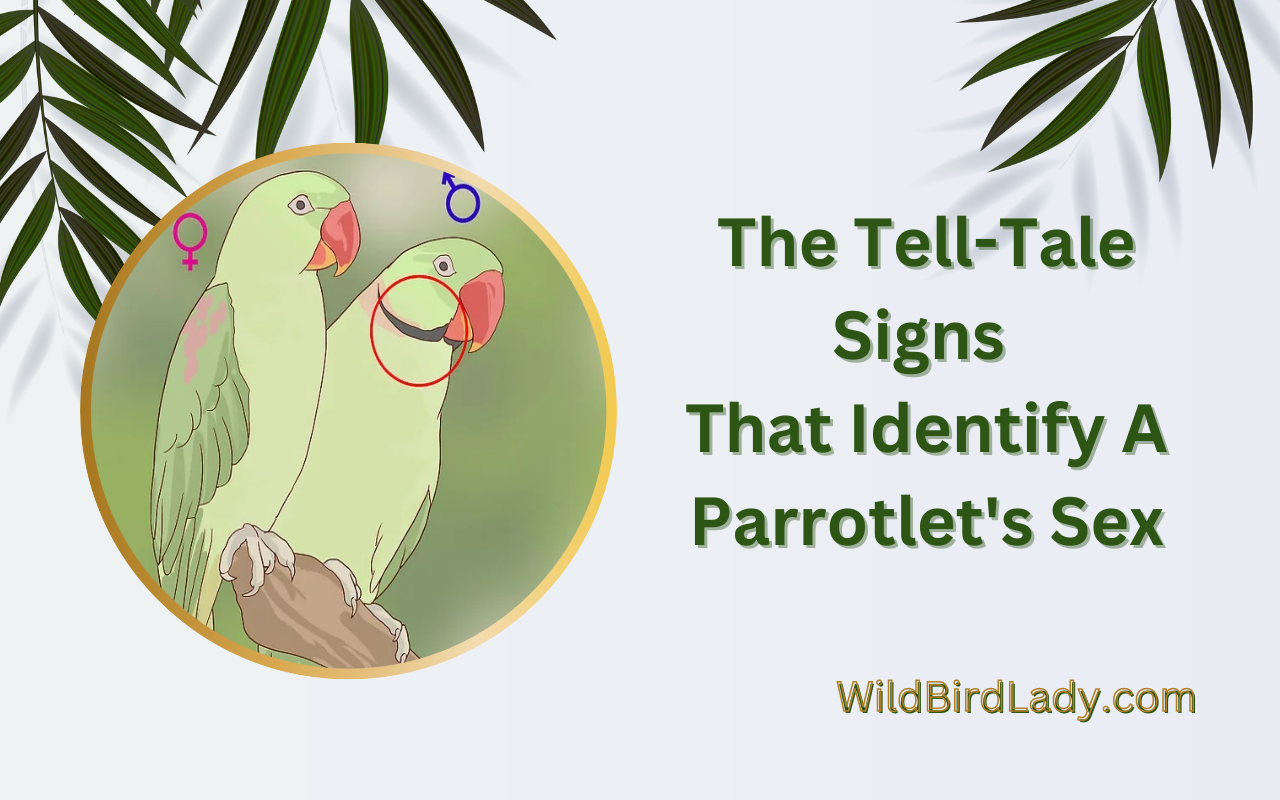The color of a parrotlet’s iris and the size of its beak can help identify its gender. Parrotlets are small birds, closely related to parakeets, that come in a variety of colors including green, blue, yellow, and white.
Like many other bird species, distinguishing between male and female parrotlets is possible but can be challenging. One way to identify the sex of your bird is by examining the colouration of the iris: males typically have a washed-out grey-blue iris, while females have a brownish-red iris.
Another method involves measuring the bird’s beak size, which can be slightly larger in males than in females. Proper identification of parrotlet sex can help bird owners provide tailored care and reduce the risk of breeding accidents.

Credit: www.reddit.com
Physical Appearance
Parrotlets are adorable, charming, and social birds that make great pets for bird lovers. They are loved for their colorful feathers, adorable personalities, and intelligence. However, for those who are interested in breeding, it is crucial to understand the difference between a male and female parrotlet.
We will explore the different physical characteristics that can help identify the gender of a parrotlet bird.
Differences In Physical Appearance Between Male And Female Parrotlets
The gender of the parrotlet is not easy to identify as the physical differences between the genders are subtle. However, with keen observation and examination of their features, it is possible to identify their gender. Here are the physical characteristics that distinguish them:
Feather Color
The first and most obvious difference between male and female parrotlets is their feather colour. In most species of parrotlets, males have vibrant and bold colors like bright blue, green, or yellow on their heads, wings, and tail. Their feathers often have a glossy shine, making them look even more beautiful.
On the other hand, females tend to have a more muted coloration, showcasing olive green, grey, and muted yellows. Moreover, the females’ feathers tend to be less glossy than males.
Beak Size And Shape
Male and female parrotlets have different sizes and shapes of beaks, which can help distinguish their gender. Males tend to have a thicker and wider beak than females. Males’ beaks tend to be more hooked, and females’ beaks are slightly flatter.
Head Shape
The shape of the head can also provide clues about the gender of the parrotlet. Males have broader and more rounded heads than females, who have a much smaller and slightly pointed skulls. Males also have a more prominent and fuller forehead compared to females.
Tail Feather Shape
The shape of the tail feathers is another distinguishing factor between male and female parrotlets. Males have long, pointed tail feathers, and females have shorter, round feathers.
Identifying the gender of the parrotlet requires a combination of observation, attention to detail, and time. While the differences are subtle, you can quickly learn how to differentiate between male and female birds with practice. It’s essential to note that while physical appearance can help determine the gender of parrotlet, it is always best to seek advice from a qualified avian veterinarian to confirm the bird’s actual gender.
Behavioural Differences
Parrotlets are colourful, playful, and intelligent birds that can make great pets. One of the essential factors that many pet owners might be interested in determining is identifying the gender of their parrotlet accurately. Although it can be a tricky and challenging task, many behavioural differences between male and female parrotlets can help with this identification.
So, let’s explore some of these differences in behaviour between male and female parrotlets in detail.
Differences In Behavior Between Male And Female Parrotlets
Both male and female parrotlets are unique in their own way, and their difference in behavior can be subtle but useful for identification purposes. Here are some of the main differences between them:
- Male parrotlets are often more vocal and prone to singing than their female counterparts.
- Female parrotlets are usually calmer and less aggressive than males, especially during breeding seasons.
- Male parrotlets tend to be more territorial and may display aggression towards any perceived threats, including humans or other birds.
- Female parrotlets are known to be more independent and exploratory than males.
Specific Behaviors To Look For In Determining Gender
Now that we have discussed general differences let’s dive deep into specific behaviors that might help determine the gender of the parrotlet. Here are some essential behaviours you can look for in determining the gender of your parrotlet:
- Check for a cere, the fleshy bit above the bird’s beak. The cere will be bright blue or purple in males and brown or tan in females.
- Observe their body language during the breeding season. During courtship, male parrotlets often display more aggressive behavior towards their female counterparts, including biting and pushing. In contrast, females tend to be more passive.
- Listen to their vocalizations. Although both males and females can vocalize, the sounds may differ. Male parrotlets often produce loud, sharp, and high-pitched noises, while females are likelier to emit softer and quieter chirps.
- Observe their play behavior. Male parrotlets are often more active and playful, while females prefer to spend time alone or with a mate.
Identifying the gender of the parrotlet can be a challenging but rewarding task. By keeping an eye on the differences in their behaviour and specific behaviors explained above, you can determine your bird’s gender more accurately.
DNA Testing
Dna Testing For Gender Identification In Parrotlets
Parrotlets are small and adorable parrots that are becoming increasingly popular as pets. However, figuring out their gender can often be challenging, especially for novice owners. Fortunately, DNA testing is now a common and reliable method to determine the gender of parrotlet before they reach sexual maturity.
Explanation Of DNA Testing For Gender Identification In Parrotlets
Dna testing is performed by collecting a blood sample from the bird’s toenail or wing. The sample is sent to a laboratory where the dna is extracted, and the gender chromosomes are analyzed. The results are then sent back to the owner via email or postal mail.
Benefits Of DNA Testing
There are several benefits to performing dna testing on parrotlets:
- Accuracy: DNA testing is nearly 100% accurate in determining a parrotlet’s gender, unlike other methods like visual identification, which is often incorrect.
- Early detection: DNA testing can be done at any age, even before maturity, which could prevent breeding unwanted offspring.
- Peace of mind: Parrotlet owners can rest easy knowing their beloved pet’s gender with certainty.
- Potential health benefits: Female parrotlets are often more prone to egg-laying-related health issues, and dna testing can help owners ensure that their bird receives proper care.
Drawbacks Of DNA Testing
Like any method, dna testing has its limitations and drawbacks:
- Cost: Dna testing can be expensive, with most laboratories charging around $30-$50 per bird.
- Stressful for some animals: Some birds may become stressed by the blood collection process required for dna testing.
- Turnaround time: The results of dna testing typically take a few days to a few weeks to return, which can lead to anxiety for the owner.
- Invasive: Collecting a blood sample can be invasive and may pose a slight risk to the bird’s health.
Dna testing is an accurate and reliable method to determine the gender of parrotlet. It has its benefits and drawbacks, which owners should consider before they decide to use this method. Ultimately, the decision to perform dna testing on parrotlet depends on the owner’s preferences and needs.
Breeding
Parrotlets are one of the most satisfying things a bird enthusiast can do. If you’re interested in breeding these birds, it’s essential to know their gender. Knowing the gender will allow you to pair them for breeding, which increases the chances of producing healthy chicks.
In this section, we’ll talk about the importance of knowing the gender of parrotlets, the role of sex-linked mutations, and their significance in breeding.
Importance Of Knowing A Parrotlet’s Gender For Breeding Purposes
Breeding parrotlets without knowing their gender can lead to frustration and disappointment. Only the opposite sexes can successfully breed, so properly identifying them is essential. Here are some reasons why:
- Helps you pair compatible birds: When you can differentiate between male and female parrotlets, pairing the right birds for breeding becomes so much easier.
- Prevents aggression: Breeding two male parrotlets or two females can lead to severe aggression problems, which can be harmful to both birds.
- Increases breeding success rate: Pairing a male and female parrotlet results in breeding success, stimulates chicks, and ensures the chicks grow up to be healthy adults.
Explanation Of Sex-Linked Mutations And Their Importance In Breeding
Sex-linked mutations are genetic traits that are controlled by sex chromosomes. They impact the color and pattern of parrotlets, providing a particular aesthetic appeal to breeders. Here’s a brief explanation of why understanding sex-linked mutations are important in breeding;
- Help choose ideal pairings: As a breeder, understanding which mutations are recessive to specific colors will allow you to make ideal pairings to produce the desired colors or patterns.
- Producing healthy chicks: Breeding parrotlet with genetic disorders or mutations can lead to genetic anomalies and health problems for the chicks.
Sex-linked mutations help you avoid such occurrences and ensure that chicks grow into healthy adults.
- Aesthetic appeal: Breeding parrotlets with specific sex-linked mutations allows breeders to create unique and stunning color patterns, increasing the value of their birds.
As a parrotlet breeder, having sound knowledge of sex-linked mutations and their importance in breeding is essential. Properly identifying the sex of your birds will help you make appropriate pairings, achieve breeding success, and produce healthy chicks that grow into vibrant and unique adults.
Frequently Asked Questions
At What Age Can You Identify A Parrotlet’s Gender?
You can usually distinguish the sex of parrotlet when they are around 6 months old. At this age, the males will have brighter plumage compared to the females.
Is It Possible To Identify A Parrotlet’s Gender By Their Behavior?
You can’t identify a parrotlet’s gender just by their behaviour. Both males and females can show similar behaviours, like chirping, playing, and bonding with their owners. Physical characteristics are the only reliable way to differentiate gender.
Can Parrotlets Change Their Feathers, Making It Difficult To Determine Their Gender?
No, parrotlets cannot change their feathers. Physical characteristics like plumage, beak size, and overall size do not change after the first molt, making it easier to determine the bird’s gender.
Conclusion
As we have seen, sexing parrotlets can be quite challenging for those who are not experienced with these birds. However, with patience and attentive observation, one can determine the sex of their parrotlet with accuracy. By looking closely at the bird’s physical characteristics and behavior, one can notice the subtle differences that distinguish the males from the females.
Additionally, dna testing can be an excellent option for those who seek a fool-proof method for sex identification. Remember, sexing your parrotlet is essential when considering breeding or adding a new bird to your flock. Knowing the sex of your bird can also help you better understand their temperament and behaviors.
We hope this guide has been helpful and informative, and that you have gained a better understanding of the tell-tale signs that identify your parrotlet’s sex.
Latest Posts
The Ultimate List: Top 8 Best Birdwatching Podcasts for Avid Birders
Looking for the top birdwatching podcasts? Here are the eight best options to tune into today! Birdwatching can be a thrilling, immersive experience that brings...
Stop Squirrels in Their Tracks: 10 Effective Ways to Safeguard Your Bird Feeder Pole
To prevent squirrels from climbing your bird feeder pole, use squirrel baffles and slippery poles. Here are ten effective ways to keep squirrels from stealing bird food and damaging bird feeders. ...


